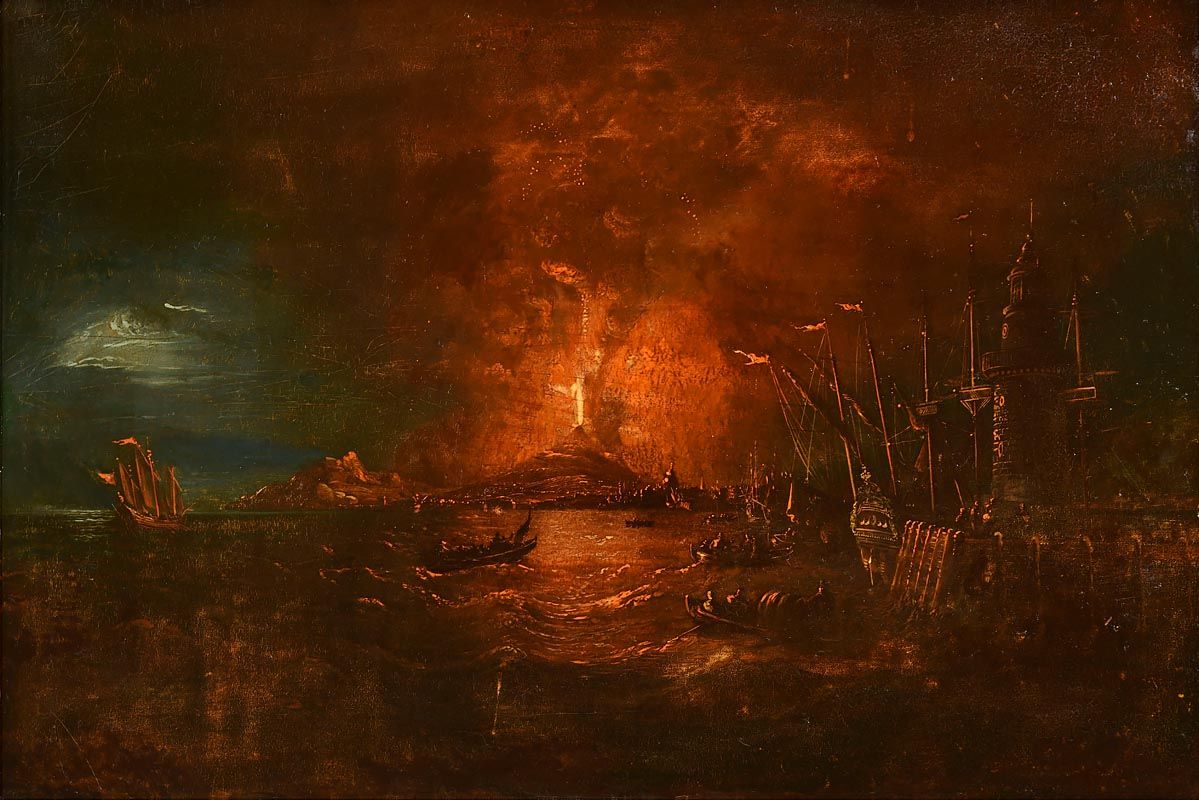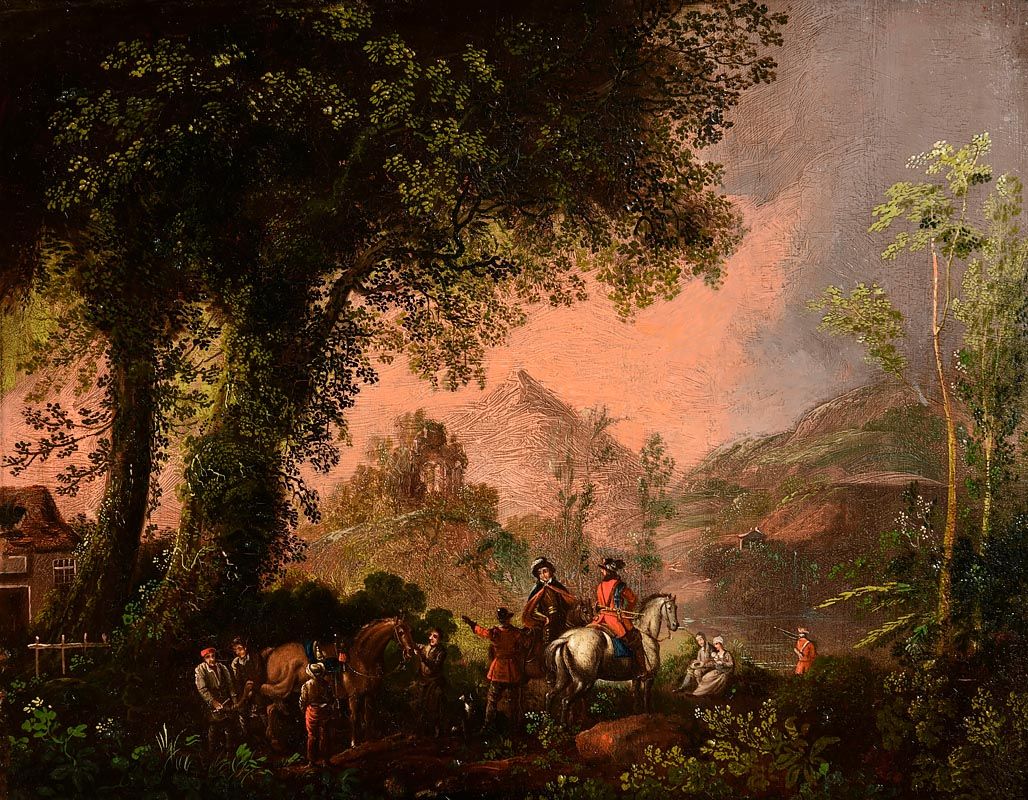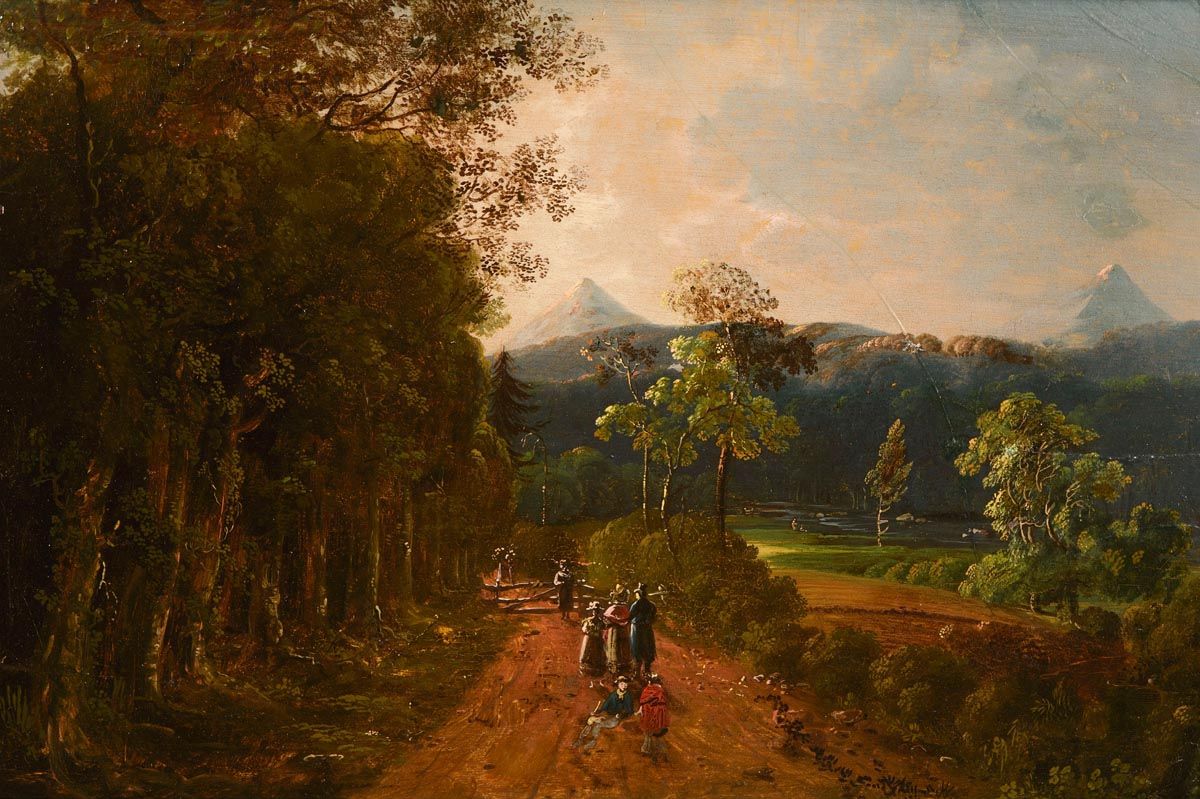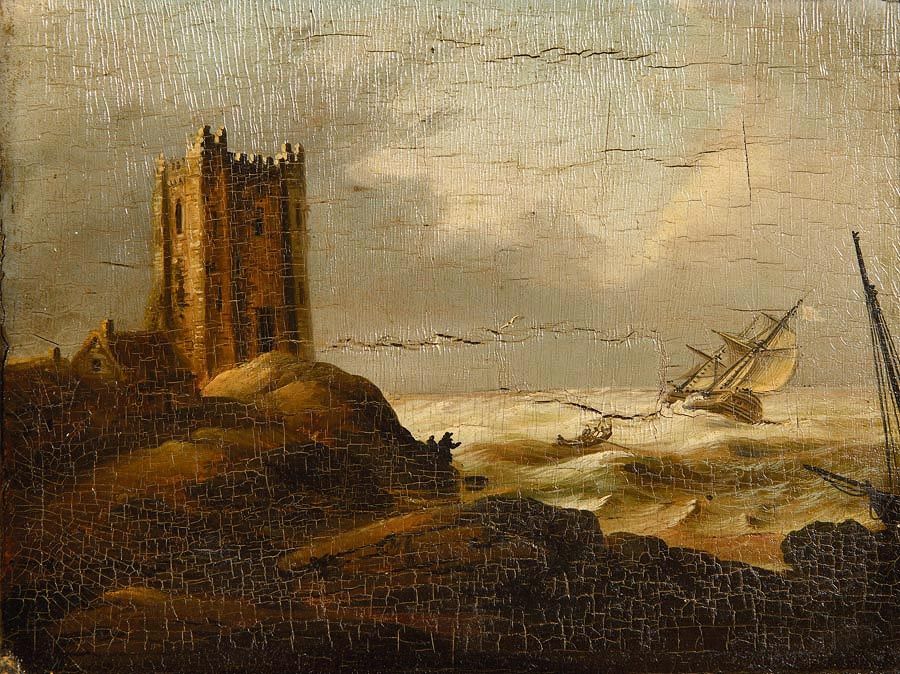William Sadler II (c.1782 – 1839) Eruption of Mount Vesuvius c. 1825, oils on panel, 53cms x 38cms (21” x 15”). (1) Please note below additional reference from Vendor . Son of a mezzotint artist of the same name, the landscape and genre painter William Sadler II was born in Dublin around 1782. According to Walter Strickland, in his Dictionary of Irish Artists, Sadler worked mainly in Dublin, producing views of that city and its environs: a favourite view was of the South Wall, with sailing ships heeling in the wind. Strickland records ‘He was also fond of painting conflagrations, and did many copies of the Old Masters’ confirming that Sadler’s paintings were mainly on mahogany panels, as is the case with the present work, a dramatic view of Mount Vesuvius near Naples, as seen at night during a volcanic eruption. Sadler was one of many artists who painted such views. Years before, in the late 1770s, Joseph Wright of Derby had produced a series of thirty works depicting different aspects of the same subject—one of these said to have been commissioned by an Irish bishop. The Bishop of Derry, the Earl of Bristol, was certainly the commissioner of a series of paintings, including one of Vesuvius, by Jacob More (1740-1793), who witnessed an eruption in 1779. In 1817, JMW Turner painted a dramatic scene of Vesuvius erupting, although this was two years before he actually visited Naples. Sadler produced several versions of Eruption of Vesuvius, of which the present work is the most distinguished. It is an imaginative work, one that links the volcanic activity of Vesuvius in the late eighteenth century to the time, in AD79, when a massive eruption engulfed the towns of Herculaneum and Pompeii in lava and ash. Sadler has included a range of classical Roman buildings in his depiction of the scene, as well as a ‘pharos’ or lighthouse, along with a variety of sailing craft and rowing boats. But in Sadler’s painting, the boats seem to be packed with sight-seers rather than people fleeing a disaster. On the right, a group of elegantly-dressed people stand on the quay wall, looking at the eruption. Sadler produced several versions of this painting. A similar work entitled A Capriccio Nightscape of the Bay of Naples with the Vesuvius Erupting was in the Slane Castle sale in October 2013. It is not known if Sadler actually travelled to Naples, or worked from secondary sources, in producing these views of Vesuvius. He also painted several panoramic views of the Battle of Waterloo, and so may have been travelling on the Continent in the years after 1815. His Battle of Waterloo is perhaps his masterpiece, while Donnybrook Fair, a late work, was in the collection of the late Brian Burns. Strickland records Sadler exhibiting in Dublin between the years 1809 and 1814, and again in 1819 and 1821. The gap of several years may have been due to his being in France and Italy. He showed at the Royal Hibernian Academy in 1828 and 1833. He was also a teacher, and among his pupils was the young James Arthur O’Connor. In 1838, a large auction of Sadler’s paintings was held, the works sold included Eruption of Mount Vesuvius, Burning of the Royal Exchange, Wreck of the Killarney and Burning of the Arcade in College Green. He died in December 1839, at his home in Manders’ Buildings, Ranelagh, leaving a widow Caroline, and several children, including two sons. The first, William, born in 1808, followed his father as a painter of landscapes. The second son, Rupert, born two years later, exhibited at the RHA in 1829 and had a business in Liffey Street restoring and cleaning paintings. Dr. Peter Murray, 2022 The vendor has brought to our attention that this painting depicts HMS Agamemnon of the Blue, with Horatio Nelson, at Napoli , 1793. Provenance : Purchased from Ashley Court , Tiverton, Devon, where it hung for at least 150 years, and to the present Vendor.
William Sadler II (c.1782 – 1839) Eruption of Mount Vesuvius c. 1825, oils on panel, 53cms x 38cms (21” x 15”). (1) Please note below additional reference from Vendor . Son of a mezzotint artist of the same name, the landscape and genre painter William Sadler II was born in Dublin around 1782. According to Walter Strickland, in his Dictionary of Irish Artists, Sadler worked mainly in Dublin, producing views of that city and its environs: a favourite view was of the South Wall, with sailing ships heeling in the wind. Strickland records ‘He was also fond of painting conflagrations, and did many copies of the Old Masters’ confirming that Sadler’s paintings were mainly on mahogany panels, as is the case with the present work, a dramatic view of Mount Vesuvius near Naples, as seen at night during a volcanic eruption. Sadler was one of many artists who painted such views. Years before, in the late 1770s, Joseph Wright of Derby had produced a series of thirty works depicting different aspects of the same subject—one of these said to have been commissioned by an Irish bishop. The Bishop of Derry, the Earl of Bristol, was certainly the commissioner of a series of paintings, including one of Vesuvius, by Jacob More (1740-1793), who witnessed an eruption in 1779. In 1817, JMW Turner painted a dramatic scene of Vesuvius erupting, although this was two years before he actually visited Naples. Sadler produced several versions of Eruption of Vesuvius, of which the present work is the most distinguished. It is an imaginative work, one that links the volcanic activity of Vesuvius in the late eighteenth century to the time, in AD79, when a massive eruption engulfed the towns of Herculaneum and Pompeii in lava and ash. Sadler has included a range of classical Roman buildings in his depiction of the scene, as well as a ‘pharos’ or lighthouse, along with a variety of sailing craft and rowing boats. But in Sadler’s painting, the boats seem to be packed with sight-seers rather than people fleeing a disaster. On the right, a group of elegantly-dressed people stand on the quay wall, looking at the eruption. Sadler produced several versions of this painting. A similar work entitled A Capriccio Nightscape of the Bay of Naples with the Vesuvius Erupting was in the Slane Castle sale in October 2013. It is not known if Sadler actually travelled to Naples, or worked from secondary sources, in producing these views of Vesuvius. He also painted several panoramic views of the Battle of Waterloo, and so may have been travelling on the Continent in the years after 1815. His Battle of Waterloo is perhaps his masterpiece, while Donnybrook Fair, a late work, was in the collection of the late Brian Burns. Strickland records Sadler exhibiting in Dublin between the years 1809 and 1814, and again in 1819 and 1821. The gap of several years may have been due to his being in France and Italy. He showed at the Royal Hibernian Academy in 1828 and 1833. He was also a teacher, and among his pupils was the young James Arthur O’Connor. In 1838, a large auction of Sadler’s paintings was held, the works sold included Eruption of Mount Vesuvius, Burning of the Royal Exchange, Wreck of the Killarney and Burning of the Arcade in College Green. He died in December 1839, at his home in Manders’ Buildings, Ranelagh, leaving a widow Caroline, and several children, including two sons. The first, William, born in 1808, followed his father as a painter of landscapes. The second son, Rupert, born two years later, exhibited at the RHA in 1829 and had a business in Liffey Street restoring and cleaning paintings. Dr. Peter Murray, 2022 The vendor has brought to our attention that this painting depicts HMS Agamemnon of the Blue, with Horatio Nelson, at Napoli , 1793. Provenance : Purchased from Ashley Court , Tiverton, Devon, where it hung for at least 150 years, and to the present Vendor.












-lg.jpg)

Testen Sie LotSearch und seine Premium-Features 7 Tage - ohne Kosten!
Lassen Sie sich automatisch über neue Objekte in kommenden Auktionen benachrichtigen.
Suchauftrag anlegen